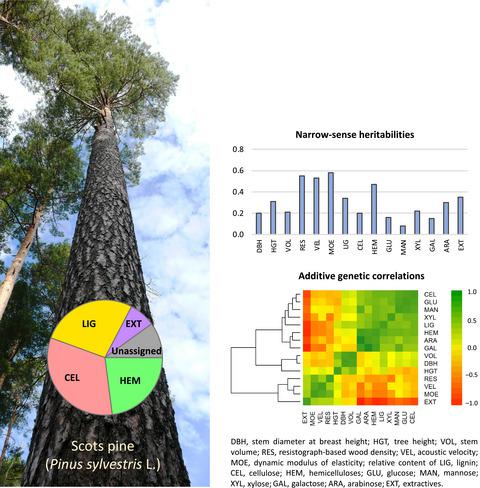当前位置:
X-MOL 学术
›
GCB Bioenergy
›
论文详情
Our official English website, www.x-mol.net, welcomes your
feedback! (Note: you will need to create a separate account there.)
Genetic improvement of the chemical composition of Scots pine (Pinus sylvestris L.) juvenile wood for bioenergy production
Global Change Biology Bioenergy ( IF 5.9 ) Pub Date : 2020-07-14 , DOI: 10.1111/gcbb.12723 Tomáš Funda 1, 2, 3 , Irena Fundová 1, 4 , Anders Fries 1 , Harry X. Wu 1, 5, 6
Global Change Biology Bioenergy ( IF 5.9 ) Pub Date : 2020-07-14 , DOI: 10.1111/gcbb.12723 Tomáš Funda 1, 2, 3 , Irena Fundová 1, 4 , Anders Fries 1 , Harry X. Wu 1, 5, 6
Affiliation

|
Chemical composition is one of the key characteristics that determines wood quality and in turn its suitability for different end products and applications. The inclusion of chemical compositional traits in forest tree improvement requires high‐throughput techniques capable of rapid, non‐destructive and cost‐efficient assessment of large‐scale breeding experiments. We tested whether Fourier‐transform infrared (FTIR) spectroscopy, coupled with partial least squares regression, could serve as an alternative to traditional wet chemistry protocols for the determination of the chemical composition of juvenile wood in Scots pine for tree improvement purposes. FTIR spectra were acquired for 1,245 trees selected in two Scots pine (Pinus sylvestris L.) full‐sib progeny tests located in northern Sweden. Predictive models were developed using 70 reference samples with known chemical composition (the proportion of lignin, carbohydrates [cellulose, hemicelluloses and their structural monosaccharides glucose, mannose, xylose, galactose, and arabinose] and extractives). Individual‐tree narrow‐sense heritabilities and additive genetic correlations were estimated for all chemical traits as well as for growth (height and stem diameter) and wood quality traits (density and stiffness). Genetic control of the chemical traits was mostly moderate. Of the major chemical components, highest heritabilities were observed for hemicelluloses (0.43–0.47), intermediate for lignin and extractives (0.30–0.39), and lowest for cellulose (0.20–0.25). Additive genetic correlations among chemical traits were, except for extractives, positive while those between chemical and wood quality traits were negative. In both groups (chemical and wood quality traits), correlations with extractives exhibited opposite signs. Correlations of chemical traits with growth traits were near zero. The best strategy for genetic improvement of Scots pine juvenile wood for bioenergy production is to decrease and stabilize the content of extractives among trees and then focus on increasing the cellulose:lignin ratio.
中文翻译:

用于生物能源生产的苏格兰松(Pinus sylvestris L.)幼林化学组成的遗传改良
化学成分是决定木材质量以及决定其是否适合不同最终产品和应用的关键特征之一。在林木改良中纳入化学成分特征需要高通量的技术,这些技术必须能够对大型育种实验进行快速,无损且具有成本效益的评估。我们测试了傅立叶变换红外(FTIR)光谱结合偏最小二乘回归是否可以替代传统湿化学规程来确定苏格兰松树中幼木的化学成分,以改善树木。FTIR光谱获得了在两种苏格兰松树(Pinus sylvestrisL.)位于瑞典北部的全同胞子代测试。使用具有已知化学成分(木质素,碳水化合物[纤维素,半纤维素及其结构单糖,葡萄糖,甘露糖,木糖,半乳糖和阿拉伯糖]的比例)和提取物的70个参考样品建立了预测模型。估计了所有化学性状以及生长(高度和茎部直径)和木材品质性状(密度和刚度)的单树狭义遗传力和加性遗传相关性。化学性状的遗传控制大部分是中等的。在主要化学成分中,半纤维素的遗传力最高(0.43-0.47),木质素和萃取物的中间遗传度(0.30-0.39),纤维素的最低遗传度(0.20-0.25)。化学性状之间的加性遗传相关性是 除提取物外,为正,而化学和木材品质性状之间为负。在两组(化学和木材质量性状)中,与提取物的相关性均显示相反的迹象。化学性状与生长性状的相关性接近零。进行生物能源生产的苏格兰松树幼树遗传改良的最佳策略是减少并稳定树木中提取物的含量,然后着重提高纤维素与木质素的比例。
更新日期:2020-07-14
中文翻译:

用于生物能源生产的苏格兰松(Pinus sylvestris L.)幼林化学组成的遗传改良
化学成分是决定木材质量以及决定其是否适合不同最终产品和应用的关键特征之一。在林木改良中纳入化学成分特征需要高通量的技术,这些技术必须能够对大型育种实验进行快速,无损且具有成本效益的评估。我们测试了傅立叶变换红外(FTIR)光谱结合偏最小二乘回归是否可以替代传统湿化学规程来确定苏格兰松树中幼木的化学成分,以改善树木。FTIR光谱获得了在两种苏格兰松树(Pinus sylvestrisL.)位于瑞典北部的全同胞子代测试。使用具有已知化学成分(木质素,碳水化合物[纤维素,半纤维素及其结构单糖,葡萄糖,甘露糖,木糖,半乳糖和阿拉伯糖]的比例)和提取物的70个参考样品建立了预测模型。估计了所有化学性状以及生长(高度和茎部直径)和木材品质性状(密度和刚度)的单树狭义遗传力和加性遗传相关性。化学性状的遗传控制大部分是中等的。在主要化学成分中,半纤维素的遗传力最高(0.43-0.47),木质素和萃取物的中间遗传度(0.30-0.39),纤维素的最低遗传度(0.20-0.25)。化学性状之间的加性遗传相关性是 除提取物外,为正,而化学和木材品质性状之间为负。在两组(化学和木材质量性状)中,与提取物的相关性均显示相反的迹象。化学性状与生长性状的相关性接近零。进行生物能源生产的苏格兰松树幼树遗传改良的最佳策略是减少并稳定树木中提取物的含量,然后着重提高纤维素与木质素的比例。











































 京公网安备 11010802027423号
京公网安备 11010802027423号